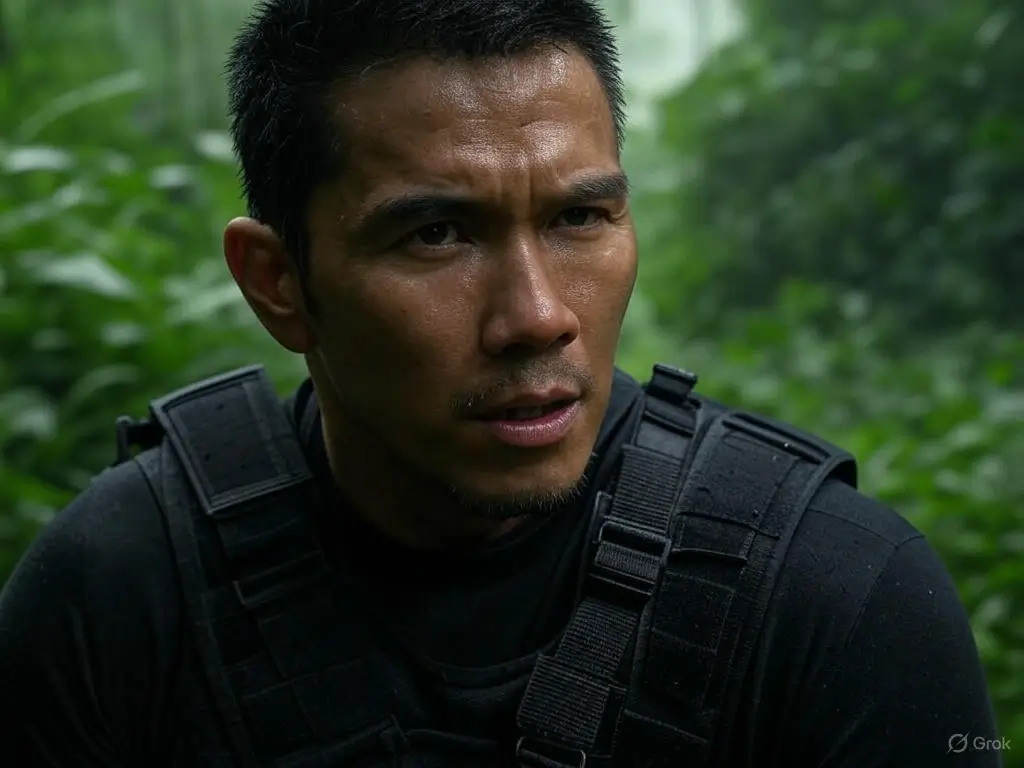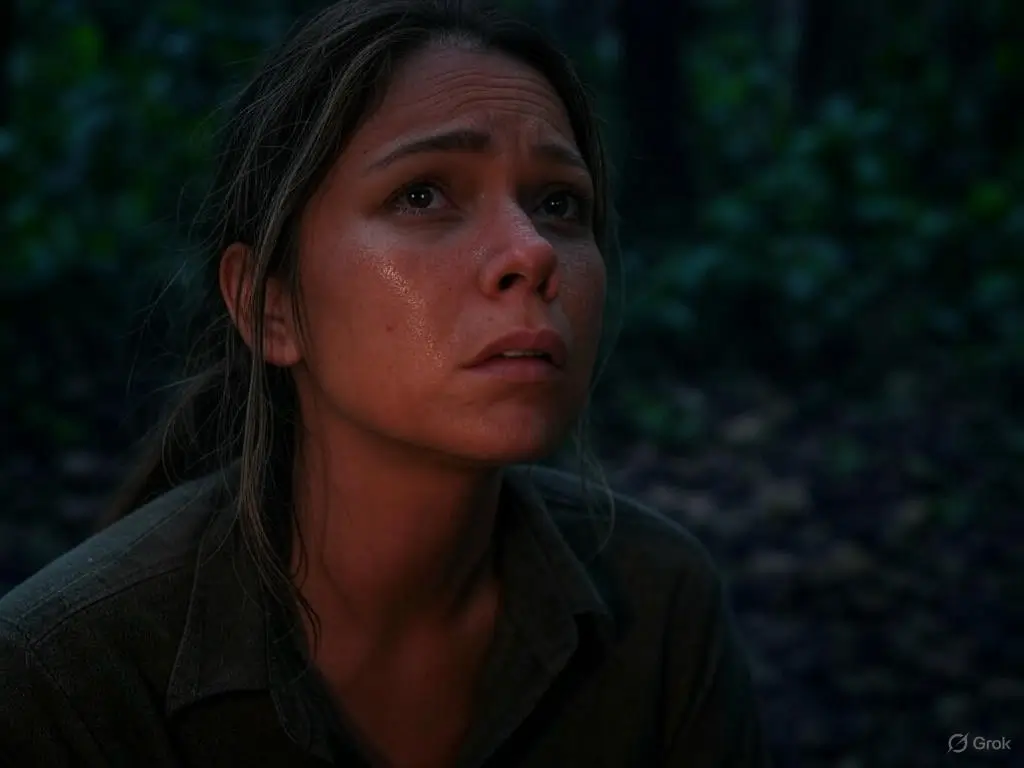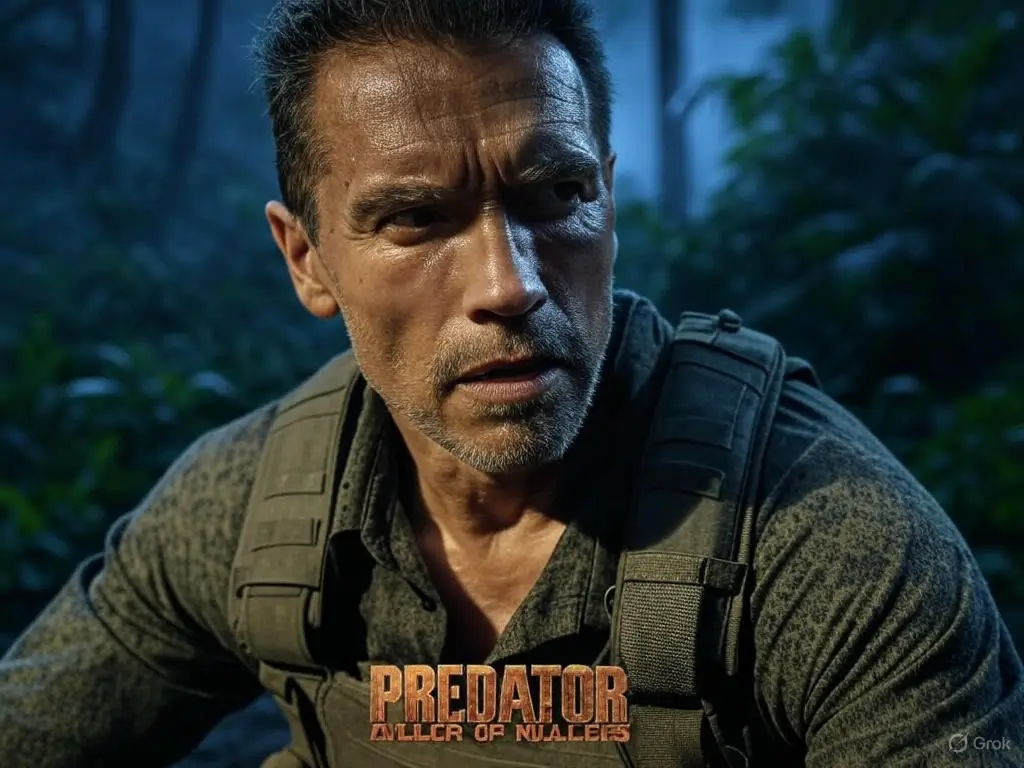Table of Contents
Introduction
Have you ever wondered what really happened when an invisible alien hunter stalked Arnold Schwarzenegger through a steamy jungle? The 1987 sci-fi action classic “Predator” has thrilled audiences for decades, but many fascinating secrets remain hidden behind the scenes of this iconic film. “Predator: Killer of Killers” wasn’t just another action movie—it revolutionized the monster movie genre with groundbreaking effects, unforgettable performances, and production challenges that would make even the toughest Hollywood veterans sweat. From costume disasters to real-life military training, these behind-the-scenes stories reveal how a troubled production ultimately created one of the most enduring sci-fi franchises in film history.
The Birth of a Classic Hunter
The Original Concept Was Very Different
When screenwriters Jim and John Thomas first created the script for “Predator: Killer of Killers,” they had a very different vision than what eventually appeared on screen. Their original idea came from a joke about Rocky running out of Earth-bound opponents and needing to fight an alien! The script, initially titled “Hunter,” featured a more insect-like alien rather than the mandible-faced hunter we know today. The story caught the attention of producer Joel Silver, who had just worked with Arnold Schwarzenegger on “Commando” and thought this new alien hunter concept would be perfect for the action star.
The early drafts focused more heavily on the alien’s ability to mimic human speech and had significantly more dialogue for the creature. The filmmakers ultimately decided a silent, mysterious killer would be more terrifying, transforming the Predator into the ultimate hunter who collects human trophies.
Casting the Perfect Team
Finding the right team of tough guys to face off against the alien hunter was crucial to making “Predator: Killer of Killers” work. Director John McTiernan wanted performers who could physically embody elite military operatives. The casting process led to an unusual team that included two future governors (Arnold Schwarzenegger and Jesse Ventura), a decorated Native American actor (Sonny Landham), and former NFL player Carl Weathers. What many fans don’t know is that Jean-Claude Van Damme was originally cast to play the Predator creature! The production team wanted someone athletic who could perform the creature’s nimble movements.
However, Van Damme quit after just two days of filming, frustrated that he would be hidden under makeup and that the original suit was too cumbersome for his martial arts moves. This casting disaster actually led to one of the most important changes in the film—bringing in 7’2″ actor Kevin Peter Hall, whose imposing height made the Predator truly menacing compared to the muscular human characters.
Production Nightmares in the Jungle
The Mexican Jungle Proved Brutal

Filming “Predator: Killer of Killers” in the remote jungles of Palenque, Mexico created enormous challenges for the cast and crew. The location was chosen for its dense, authentic jungle setting, but the conditions quickly became unbearable. Daily temperatures soared above 100 degrees Fahrenheit with humidity reaching 95 percent. The actors, wearing heavy military gear and carrying real weapons for authenticity, lost significant weight during filming. Arnold Schwarzenegger reportedly lost 25 pounds despite his rigorous fitness routine.
The remote location meant limited access to modern facilities, with cast and crew facing everything from stomach illnesses to dangerous wildlife encounters. Jesse Ventura later revealed he was hospitalized after an allergic reaction to local plants. The difficult conditions ultimately contributed to the film’s authentic look of stress and exhaustion among the characters, something no amount of acting could have replicated. Equipment frequently malfunctioned in the humid environment, causing expensive delays that nearly convinced the studio to cancel the production altogether.
The Predator Suit Disaster
The original Predator costume design became one of Hollywood’s most infamous production disasters. The initial creature, designed to look more insect-like with a long neck and dog-like head, was universally mocked by the crew when it appeared on set. The red lobster-like suit made the creature look comical rather than threatening. Jean-Claude Van Damme, who was originally cast to play the monster, complained he couldn’t move properly in the cumbersome outfit. After spending nearly $1.5 million on this failed design, the production shut down for several months while special effects legend Stan Winston (known for his work on “The Terminator” and “Aliens”) was brought in to completely redesign the creature.
Interestingly, the iconic mandible design we know today was actually inspired by a suggestion from director James Cameron, who was chatting with Winston on a plane ride. Cameron sketched a creature with mandibles, which Winston developed into the now-famous Predator look. This expensive mistake actually resulted in one of cinema’s most recognizable monsters, proving that sometimes creative disasters lead to unexpected breakthroughs.
Military Authenticity in “Predator: Killer of Killers”
Real Military Training for the Cast
Director John McTiernan insisted on authentic military behavior for the special forces team in “Predator: Killer of Killers.” To achieve this, the actors underwent intensive training with military consultant Gary Goldman, a veteran who had served in Vietnam. The cast spent several weeks learning proper weapon handling, tactical movement, and communication techniques. They were required to perform their own stunts whenever possible to maintain the illusion of a cohesive military unit. The actors also lived together in jungle conditions before filming began to develop genuine camaraderie.
This preparation shows on screen in their natural interactions and tactical movements through the jungle. Jesse Ventura, himself a former Navy SEAL, helped coach the other actors on authentic military jargon and behavior. The training was so effective that several military experts have praised the film for depicting one of Hollywood’s most convincing special forces units, despite the fantastical alien hunter premise. This commitment to realism helped elevate “Predator: Killer of Killers” beyond typical action fare into something more credible and immersive.
Those Impressive Weapons Were Real
The impressive firepower displayed in “Predator: Killer of Killers” wasn’t just Hollywood magic—the production used actual military-grade weapons firing blanks to create authentic effects. Jesse Ventura’s character wielded a hand-held M134 minigun nicknamed “Old Painless” that normally would be mounted on aircraft or vehicles. The weapon weighed around 70 pounds with an additional 30 pounds of batteries to power it, making Ventura’s handling of it all the more impressive. The firearms used in the film had to be specially modified to fire blanks safely, and even then, they created enormous noise and heat.
During the scene where the team collectively fires into the jungle, the actors were using live blank ammunition that produced real muzzle flashes and ejected shell casings. This commitment to realistic weapon portrayal added greatly to the film’s visceral impact. Sound designers later enhanced these authentic weapon sounds to create the distinctive audio experience that helps make the jungle assault scenes so memorable. The production spent nearly half a million dollars just on ammunition for these sequences, demonstrating the filmmakers’ commitment to creating believable action.
Special Effects Breakthroughs
The Invisible Predator Effect Was Revolutionary
The Predator’s cloaking technology, which rendered the alien nearly invisible with just a subtle outline visible to viewers, represented a significant technical achievement for 1987. Creating this effect for “Predator: Killer of Killers” required innovative solutions from the special effects team. They filmed the scenes twice—once with the jungle and actors only, and again with the actor in the Predator suit against a red screen.
These elements were then combined using an optical printing process, carefully adjusting the transparency to create the “active camouflage” effect. For scenes where the Predator moved through water, the visual effects team had to painstakingly animate the invisibility effect frame by frame. This technique was especially challenging when capturing the creature’s movement through the jungle, requiring precise matching of camera movements in both shots.
The thermal vision sequences used by the Predator represented another technical challenge, achieved by filming the actors with a special infrared camera and then adding color overlays to create the heat-signature look. These innovations influenced countless films that followed, establishing a visual language for depicting invisibility that remained the industry standard until digital techniques eventually replaced these analog methods decades later.
Creating the Predator’s Iconic Sound
The distinctive sounds of the Predator creature became as iconic as its visual appearance. Sound designer Stephen Hunter Flick created the alien’s memorable clicking sounds by using a combination of crab claws snapping together and backwards slowed-down rattlesnake rattles. The Predator’s growls blended samples from multiple animals, including bears, lions, and walruses, processed through electronic filters to create something truly otherworldly. For the creature’s spine-chilling roar, voice actor Peter Cullen (later famous as the voice of Optimus Prime in Transformers) provided the basis, which was then electronically manipulated.
Cullen has said he created the sound by imagining a horseshoe crab dying on the beach! The Predator’s vocal effects were carefully designed to escalate throughout the film, becoming more expressive and threatening as the creature’s mask comes off and it faces Schwarzenegger in the final battle. This progression helped convey the alien’s increasing frustration and rage. The sound design team also created the distinctive electric sizzle of the Predator’s technology by recording electrical arcs and processing them digitally, establishing audio cues that would become instantly recognizable throughout the franchise.
Cultural Impact and Legacy
The Handshake That Became a Meme
One of the most enduring images from “Predator: Killer of Killers” wasn’t even in the script. The epic muscular handshake between Dutch (Schwarzenegger) and Dillon (Weathers) was improvised on set. When Dillon first arrives by helicopter, the two characters greet each other with an intensely masculine arm clasp that showcases their bulging biceps. The moment came from a genuine competition between the two bodybuilders, with both actors trying to out-flex each other. Director John McTiernan recognized the perfect visual representation of male bravado and kept the cameras rolling.
This brief interaction became one of cinema’s most recognized greetings, replicated by fans worldwide and eventually evolving into a popular internet meme decades later. The iconic moment perfectly encapsulated the film’s hypermasculine energy and has been parodied in numerous movies and TV shows. Carl Weathers later revealed they actually shot multiple takes of the handshake, with each actor trying to make their bicep look more impressive than the other’s—a real-life competition that mirrors their characters’ rivalry perfectly.
A Franchise Was Born
“Predator: Killer of Killers” faced numerous production difficulties and was not initially expected to become a major hit. However, its unique blend of action, science fiction, and horror resonated with audiences, grossing over $98 million worldwide against its $15-18 million budget. This success launched a multimedia franchise that continues to expand decades later. The original film spawned direct sequels, crossover films with the Alien franchise, novels, comic books, video games, and action figures. Each subsequent film has explored different aspects of Predator culture and hunting techniques, gradually expanding the mythology of these interstellar hunters. The 2010 film “Predators” returned to the formula of the original, while 2018’s “The Predator” and 2022’s “Prey” took the concept in new directions.
The franchise’s longevity demonstrates the enduring appeal of the original concept. Interestingly, many cast and crew members from the original film reported thinking they were making a rather standard action movie during production and were surprised by its cultural staying power. Arnold Schwarzenegger later called it one of his favorite films from his career, though he declined to return for any sequels despite multiple offers.
On-Set Stories and Rivalries
The Famous Pushing Competition
The testosterone levels ran extraordinarily high on the set of “Predator: Killer of Killers,” leading to some legendary behind-the-scenes competitions. Most famous was the daily “body push” contest between Jesse Ventura and Arnold Schwarzenegger. Each morning before filming, the two physically imposing actors would see who could do more push-ups. Ventura, proud of his military background and physical prowess, claimed he could match Schwarzenegger’s strength. According to set reports, Ventura would complete his push-ups in his trailer, emerge claiming impressive numbers, and challenge Schwarzenegger to beat him.
Unknown to Ventura, Arnold had convinced the crew to spy on him to get his actual count, then would always do just a few more. This friendly rivalry continued until the infamous bicep-measuring incident. Ventura had been boasting about having 16-inch biceps, supposedly bigger than Schwarzenegger’s. The production’s medical team was asked to measure both men’s arms, revealing that Arnold’s biceps were actually 19 inches to Ventura’s 16. The back-and-forth competition between the actors mirrored their characters’ rivalry and created genuine tension that translated effectively to the screen.
The Hidden Dangers of Filming

The jungle filming location created numerous dangerous situations that weren’t apparent to viewers. Actor Sonny Landham, who played tracker Billy, had such a volatile reputation that the studio required a bodyguard to accompany him—not to protect Landham, but to protect others from him! The production team encountered numerous venomous snakes during filming, with several crew members requiring medical attention after close calls. During the waterfall jumping scene, the stunt was performed with real falls of over 40 feet into the water below. One stuntman was briefly knocked unconscious and had to be rescued by the safety team.
The scene where Dutch constructs traps in the jungle was particularly hazardous, with several crew members suffering injuries from the sharpened bamboo sticks used as props. The final battle sequence between Dutch and the Predator required Schwarzenegger to be covered in cold mud for hours during night shoots, leading to him nearly suffering hypothermia despite the tropical location. The production’s remote nature meant medical help was often hours away, adding additional risk to already dangerous stunts and conditions.
Conclusion
“Predator: Killer of Killers” stands as a masterclass in overcoming production challenges to create cinema history. From a disastrous original creature design to brutal jungle filming conditions, the odds seemed stacked against the film becoming a classic. Yet these very difficulties forced creative solutions that enhanced the final product. The military authenticity, groundbreaking special effects, and genuine camaraderie among the cast helped elevate what could have been a standard action film into something special. The film’s enduring legacy proves that sometimes the most troubled productions create the most memorable cinematic experiences. Next time you watch this sci-fi action masterpiece, you’ll appreciate the incredible effort, innovation, and perseverance that went into bringing the ultimate hunter to life.
Summary Table: Behind-the-Scenes Secrets of Predator: Killer of Killers
| Secret | Description |
|---|---|
| Original Concept | Started as “Hunter” with an insect-like alien, inspired by a joke about Rocky fighting an alien opponent |
| Original Predator Actor | Jean-Claude Van Damme was initially cast but quit after two days due to costume issues |
| Filming Location Challenges | Mexican jungle filming featured 100°F temperatures and 95% humidity, causing illness and equipment failures |
| Original Suit Disaster | The first Predator design cost $1.5 million but looked laughably bad, causing production shutdown |
| Military Training | Cast underwent authentic special forces training with military consultant Gary Goldman |
| Real Weapons | Production used actual military-grade weapons firing blanks, including Jesse Ventura’s 70-pound minigun |
| Invisibility Effect | Revolutionary optical printing technique combined separate footage to create the Predator’s cloaking effect |
| Iconic Sounds | Predator’s sounds combined crab claws, rattlesnakes, bear growls, and voice actor Peter Cullen’s performance |
| Epic Handshake | The famous muscular greeting between Schwarzenegger and Weathers was improvised on set |
| Cast Rivalry | Daily push-up competitions and bicep-measuring contests between Schwarzenegger and Ventura created real tension |

